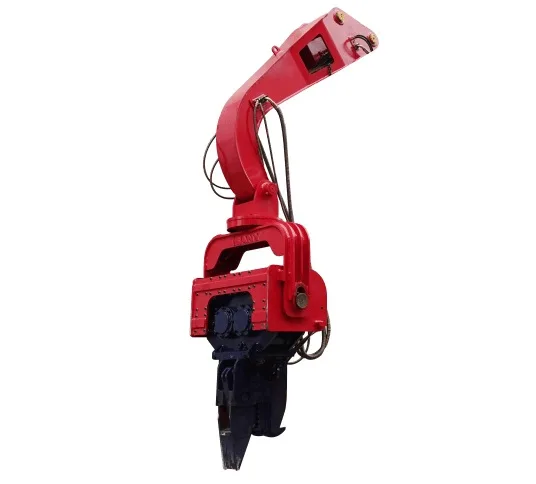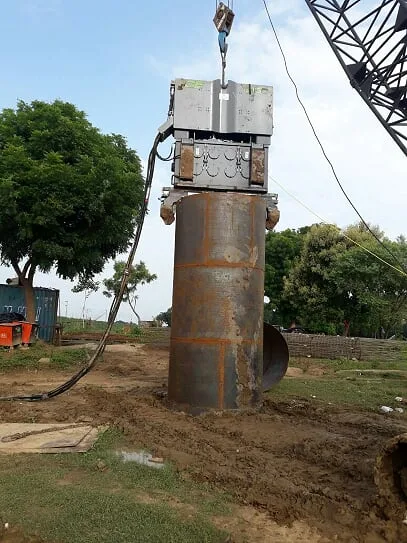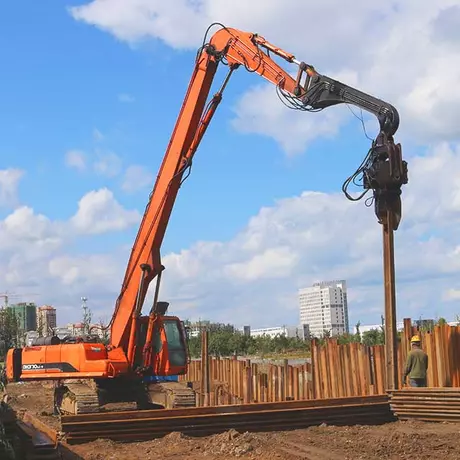A vibratory pile driving hammer is a specialised construction equipment used to drive piles into the ground. It operates by generating high-frequency vibrations, which reduce the friction between the pile and the surrounding soil, allowing for easier penetration. The hammer typically consists of an eccentric weight or weights that rotate rapidly, producing the vibrations. These hammers are particularly effective in driving piles in sandy or granular soils and are often used in projects such as bridge construction, building foundations, and marine structures.
Components of vibratory pile driving hammer
- Eccentric Weight: Generates vibrations by rapid rotation.
- Hydraulic System: Powers the hammer and controls its functions.
- Clamps or Grippers: Securely hold the pile in place during driving.
- Power Unit: Engine or motor that drives the hydraulic system.
- Control System: Regulates hammer operation parameters.
- Pile Cushion or Pile Cap: Protects the pile and distributes driving force.
- Support Structure: Mounts the hammer on a crane, excavator, or rig for stability and manoeuvrability.
How does a vibratory pile driving hammer work?
A pile driving vibratory hammer works by generating vibrations that liquefy the soil around a pile, allowing it to be driven into the ground with less resistance. Here’s how it works:
Preparation: The vibratory hammer is attached to the pile, typically via clamps or hydraulic connections.

Activation: The hammer is activated, causing an eccentric weight inside to rotate rapidly. This rotation generates vibrations that are transferred to the pile and into the surrounding soil.

Soil Liquefaction: The vibrations liquefy the soil particles around the pile, reducing friction and allowing the pile to penetrate deeper into the ground more easily.

Driving the Pile: As the pile is driven downward, the vibratory hammer continues to apply vibrations, assisting in the driving process. The vibrations also help to compact the soil around the pile, increasing its stability.

Completion: Once the pile reaches the desired depth, the vibratory hammer is deactivated, and the pile driving process is complete. The soil around the pile settles, providing a stable foundation for construction.
Where are the vibratory pile driving hammers used?
- Building foundations in urban areas.
- Road and highway projects for structural support.
- Bridge construction for abutments and piers.
- Marine construction for docks, seawalls, and waterfront structures.
- Offshore wind farms for turbine foundation installation.
- Civil engineering projects including dams, levees, and underground structures.
Advantages of vibratory pile driving hammers
- Increased efficiency through reduced soil friction.
- Minimal soil disturbance compared to impact hammers.
- Versatility across various soil types.
- Lower noise and vibration levels.
- Precise control over driving parameters.
- Cost-effective due to faster installation.
- Enhanced safety for workers and nearby structures.
- Reduced environmental impact due to gentler operation.
- Greater productivity through continuous driving.
- Improved accuracy in pile placement.
- Compatibility with various pile types and sizes.
- Ability to drive piles to greater depths.
- Reduced need for pre-augering or soil removal.
- Increased flexibility in challenging site conditions.
Types of vibratory pile driving hammers
1. Diesel Hammers: Diesel vibratory hammers stand out for their robustness and are specially engineered to effectively drive piles even in the toughest soil conditions. Their main advantage lies in their strong impact force, which allows them to efficiently drive batter piles, H-beams, sheet piles, and piles in bearing layers. The diesel power source provides ample energy to overcome resistance from dense or compacted soils, making them suitable for a wide range of construction projects. These hammers typically feature a simple design, making them relatively easy to maintain and operate on-site. Their versatility and reliability make them a preferred choice for driving piles where other methods may struggle.

2. Impact-Vibration Hammers: Impact-vibration hammers combine the benefits of both vibratory and impact forces to drive piles effectively, featuring counter-rotating eccentrics and regulated by springs linked to the frame, they offer precise control over vibration frequency and force. This versatility allows them to adapt to different pile types and soil conditions, providing efficient pile driving while minimizing soil disturbance. The ability to adjust both vibratory and impact forces makes them suitable for driving various types of piles with precision, ensuring optimal performance in a wide range of construction applications.
3. Hydraulic Vibratory Hammers: Hydraulic vibratory hammers are known for their efficiency, power, and versatility in pile driving operations. Utilizing hydraulic power, they generate vibrations that enable them to drive piles effectively into different soil types. One of their key advantages is the flexibility to adjust vibration frequency and force according to specific project requirements. This adaptability ensures optimal performance and allows for efficient pile installation in various construction applications. Hydraulic vibratory hammers are also relatively easy to operate and maintain, making them a preferred choice for many construction projects.

4. Excavator Mounted Vibratory Hammers: Excavator mounted vibratory hammers offer versatility and adaptability in piling operations. Mounted on excavators, they can install a wide range of pile types, including trench sheets, sheet piles, “H” piles, tubular piles, concrete piles, and timber piles. This versatility makes them well-suited for smaller piling jobs where space or access may be limited. Additionally, their ease of attachment to excavators allows for quick setup and mobility on-site, enhancing productivity and efficiency in pile driving operations.

5. Hydraulic Vibro Hammers: Hydraulic vibro hammers serve as both pile drivers and extractors, utilizing periodic excitation force to liquefy the soil around the pile. This innovative design reduces friction between the pile and soil, making pile driving and extraction more efficient, especially in cohesive or dense soil conditions. One of their key advantages is the ability to adjust the excitation force to match specific soil conditions, ensuring optimal performance and minimizing soil disturbance. Hydraulic vibro hammers are particularly useful in situations where traditional pile driving methods may encounter challenges due to soil conditions or environmental constraints.

6. Crane Suspended Vibratory Hammers: Crane suspended vibratory hammers assist in the easy driving of sheet piles and pipes by providing vertical vibrations that loosen the soil. This type of vibratory hammer is typically used in situations where crane access is available, offering a reliable method for driving piles while minimizing soil disturbance and surrounding structure impact. The crane suspended configuration allows for easy attachment and operation, making it suitable for various construction projects where crane access is available. Additionally, the vertical vibration provided by these hammers ensures efficient pile driving while minimizing noise and vibration impact on surrounding structures.

Why the demand of vibratory hammers?
The demand for pile driving vibratory hammers is primarily influenced by several key factors:
1. Construction Activity: As construction activity increases, there is a greater demand for pile driving equipment, including vibratory hammers, to support infrastructure projects such as building foundations, bridges, ports, and offshore structures.
2. Urbanization: With rapid urbanization occurring in many regions globally, there is a growing need for efficient and effective pile driving methods to support the construction of high-rise buildings, transportation networks, and other urban infrastructure.
3. Infrastructure Development: Government investments in infrastructure projects, such as roads, railways, airports, and utilities, drive the demand for pile driving equipment to install various types of piles for structural support.
4. Environmental Considerations: Vibratory hammers are often preferred over impact hammers due to their lower noise and vibration levels, making them more suitable for use in urban areas and environmentally sensitive locations.
5. Cost and Time Savings: Vibratory hammers are known for their speed and efficiency in driving piles, resulting in cost and time savings for construction projects.
Conclusion
Pile driving vibratory hammers offer numerous advantages, including increased productivity, reduced environmental impact, and improved safety compared to traditional pile driving methods. Their ability to minimize soil disturbance and noise pollution makes them particularly appealing for projects in sensitive environments. As the construction industry evolves, so will the vibratory hammer, continuing to play a central role in driving efficiency in pile driving forward.
Image Source: suretech.co.in, omsvibro.com, sany.in

